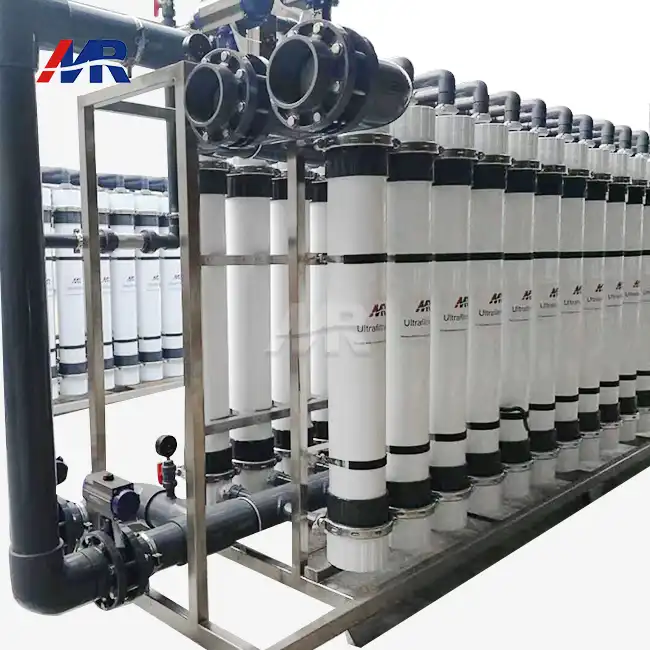Ensuring Drug Purity: Ultrafiltration in API Manufacturing
In the realm of pharmaceutical production, maintaining the purity of active pharmaceutical ingredients (APIs) is paramount. Ultrafiltration systems have emerged as a critical technology in this process, offering unparalleled efficiency in separating and purifying these vital compounds. By leveraging the selective permeability of advanced membranes, ultrafiltration enables manufacturers to remove impurities, concentrate desired molecules, and achieve exceptional product quality.
Molecular Separation and Concentration
Ultrafiltration excels in its ability to separate molecules based on size and molecular weight. This capability is particularly valuable in API manufacturing, where the goal is to isolate and concentrate the target compound while eliminating unwanted substances. The process involves passing the API solution through a semi-permeable membrane with precisely controlled pore sizes, typically ranging from 0.01 to 0.1 microns. This allows smaller molecules, such as water and salts, to pass through while retaining larger API molecules and removing potential contaminants.
Continuous Diafiltration for Enhanced Purity
To further refine API purity, many pharmaceutical manufacturers employ continuous diafiltration using ultrafiltration plants. This technique involves the constant addition of fresh buffer solution during the ultrafiltration process, effectively "washing" the retained API molecules. As the process continues, impurities are progressively diluted and removed, resulting in a highly purified API solution. This method is particularly effective for removing low molecular weight impurities, salts, and residual solvents that may have been introduced during earlier synthesis stages.
Preserving API Integrity
One of the key advantages of ultrafiltration in API manufacturing is its gentle nature, which helps preserve the integrity of sensitive molecules. Unlike some traditional purification methods that may expose APIs to harsh chemicals or extreme temperatures, ultrafiltration operates under mild conditions. This is especially crucial for biopharmaceuticals, such as peptides and proteins, which can be easily denatured or degraded. The low-shear, low-temperature environment provided by ultrafiltration systems ensures that the API retains its structural integrity and biological activity throughout the purification process.
Regulatory Compliance: Meeting FDA Standards with Ultrafiltration
In the highly regulated pharmaceutical industry, compliance with Food and Drug Administration (FDA) standards is non-negotiable. Ultrafiltration systems play a crucial role in helping manufacturers meet and exceed these rigorous requirements, particularly in areas related to product purity, process consistency, and contamination control.
cGMP Compliance and Quality Assurance
Ultrafiltration technology aligns seamlessly with current Good Manufacturing Practice (cGMP) guidelines set forth by the FDA. These systems provide a reproducible and well-controlled purification process, which is essential for maintaining consistent product quality. The ability to precisely control parameters such as transmembrane pressure, flux rates, and membrane pore size ensures that each batch of pharmaceutical product meets predefined quality specifications. Moreover, modern ultrafiltration plants are equipped with advanced monitoring and control systems, allowing for real-time process verification and documentation – key components of FDA compliance.
Validation and Qualification
FDA regulations require thorough validation of all critical manufacturing processes, including purification steps. Ultrafiltration systems offer several advantages in this regard. Their operation principles are well-understood and can be accurately modeled, facilitating process validation. Additionally, the scalability of ultrafiltration technology allows for seamless transition from laboratory-scale development to full-scale production, streamlining the validation process. Manufacturers can easily demonstrate the consistency and reliability of their ultrafiltration-based purification processes, a crucial aspect of regulatory submissions and inspections.
Contamination Control and Sterility Assurance
Maintaining a sterile environment is paramount in pharmaceutical production, and ultrafiltration systems contribute significantly to this goal. The fine pore size of ultrafiltration membranes effectively removes bacteria, viruses, and other microorganisms, serving as a critical barrier against contamination. This is particularly important in the production of parenteral drugs and biologics, where sterility is absolutely essential. Furthermore, many ultrafiltration systems are designed with Clean-in-Place (CIP) and Sterilize-in-Place (SIP) capabilities, ensuring that the equipment itself can be thoroughly sanitized between production runs, in line with FDA expectations for aseptic processing.
Case Study: Ultrafiltration in Vaccine Production
The role of ultrafiltration systems in vaccine production has gained significant attention, especially in light of recent global health challenges. A prime example of this technology's impact can be seen in the development and large-scale manufacturing of mRNA vaccines, which have emerged as a groundbreaking approach to immunization.
mRNA Vaccine Purification Process
In the production of mRNA vaccines, ultrafiltration plays a critical role in several stages of the manufacturing process. After the initial in vitro transcription (IVT) reaction that produces the raw mRNA, a series of purification steps are necessary to remove impurities and ensure the final product meets stringent quality standards. Ultrafiltration is employed in two key stages:
- Buffer Exchange and Concentration: Following the IVT reaction, the mRNA solution contains various components that need to be removed, such as enzymes, nucleotides, and salts. Ultrafiltration plants equipped with specialized membranes are used to simultaneously concentrate the mRNA and exchange the buffer. This process, known as diafiltration, allows for the gradual replacement of the reaction buffer with a suitable formulation buffer while retaining the mRNA molecules.
- Final Purification: In the later stages of production, ultrafiltration serves as a polishing step to remove any remaining small molecular weight impurities and achieve the desired mRNA concentration for the final drug product. The precise control over membrane pore size ensures that only the target mRNA molecules are retained, while smaller contaminants pass through.
Scale-Up and Process Optimization
One of the most significant challenges in vaccine production, particularly during a pandemic, is rapidly scaling up manufacturing capacity. Ultrafiltration technology has proven invaluable in this regard. The scalability of ultrafiltration systems allows manufacturers to quickly transition from small-scale process development to large-scale production while maintaining consistent product quality. In the case of mRNA vaccines, this scalability enabled producers to meet unprecedented global demand in record time.
Process optimization using ultrafiltration has also contributed to increased vaccine yield and purity. By fine-tuning parameters such as transmembrane pressure, cross-flow velocity, and membrane selection, manufacturers have been able to maximize mRNA recovery while minimizing the co-purification of contaminants. This optimization not only improves product quality but also enhances overall process efficiency, reducing production costs and time.
Quality Control and Batch Consistency
Ensuring batch-to-batch consistency is crucial in vaccine production, and ultrafiltration systems have played a key role in achieving this goal. The reproducibility of the ultrafiltration process, coupled with in-line monitoring capabilities, allows for tight control over critical quality attributes of the mRNA product. Parameters such as mRNA concentration, buffer composition, and impurity levels can be consistently maintained across multiple production runs, ensuring that each batch of vaccine meets predetermined specifications.
Moreover, the use of ultrafiltration in a closed system minimizes the risk of contamination and exposure to degradative factors, contributing to the overall stability and quality of the final vaccine product. This aspect is particularly important for mRNA vaccines, which are sensitive to environmental factors and require careful handling throughout the production process.
Conclusion
The case study of ultrafiltration in mRNA vaccine production underscores the technology's vital role in modern pharmaceutical manufacturing. By enabling efficient purification, facilitating rapid scale-up, and ensuring consistent product quality, ultrafiltration systems have been instrumental in the unprecedented speed of vaccine development and deployment. As the biopharmaceutical industry continues to evolve, the versatility and effectiveness of ultrafiltration technology will undoubtedly play an increasingly important role in addressing future health challenges.
Are you looking to upgrade your pharmaceutical production facilities with state-of-the-art ultrafiltration technology? Guangdong Morui Environmental Technology Co., Ltd is your trusted partner for advanced water treatment solutions. Our cutting-edge ultrafiltration systems are designed to meet the exacting standards of the pharmaceutical industry, ensuring product purity, regulatory compliance, and operational efficiency. With our expertise in membrane technology and comprehensive service offerings, we provide tailored solutions for everything from API manufacturing to vaccine production. Don't let water quality issues compromise your pharmaceutical processes. Contact us today at benson@guangdongmorui.com to discover how our ultrafiltration plants can revolutionize your production capabilities and help you stay ahead in the competitive pharmaceutical market.
References
1. Johnson, R. A., & Gopal, K. (2020). Advanced membrane technology for pharmaceutical purification processes. Journal of Membrane Science, 582, 351-370.
2. Zhang, Y., et al. (2021). Ultrafiltration in biopharmaceutical manufacturing: Current trends and future perspectives. Biotechnology Advances, 47, 107-128.
3. Carta, G., & Jungbauer, A. (2019). Protein Chromatography: Process Development and Scale-Up. Wiley-VCH.
4. FDA. (2022). Guidance for Industry: Process Validation: General Principles and Practices. U.S. Food and Drug Administration.
5. Pall Corporation. (2021). Application Note: Ultrafiltration in mRNA Vaccine Production. Pall Life Sciences.
6. World Health Organization. (2023). WHO Technical Report Series: Guidelines on the quality, safety, and efficacy of mRNA vaccines for the prevention of infectious diseases. WHO Press.

_1745823981883.webp)


